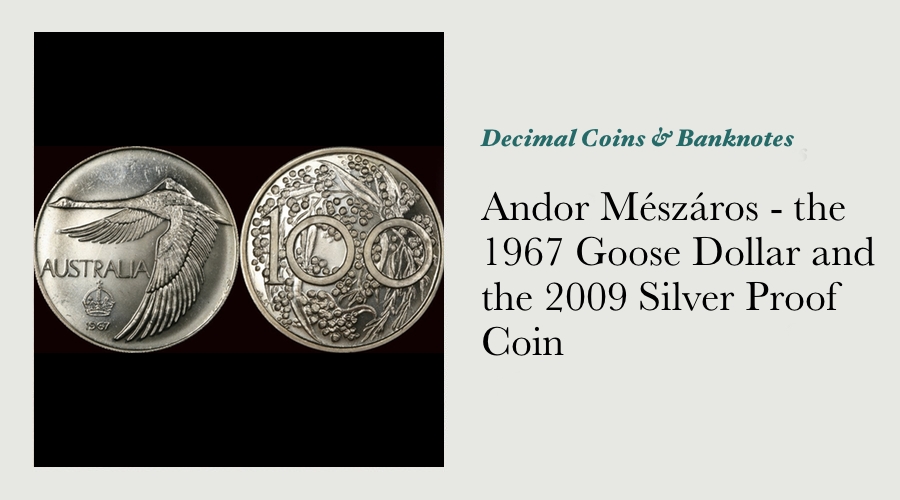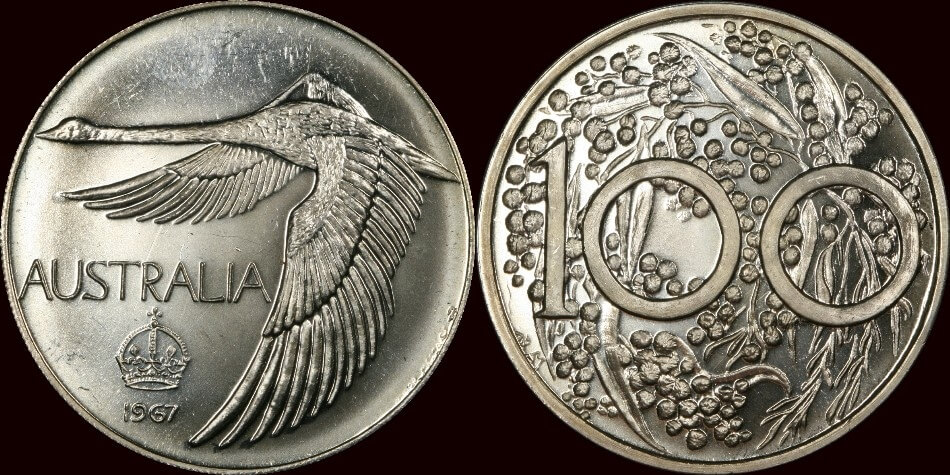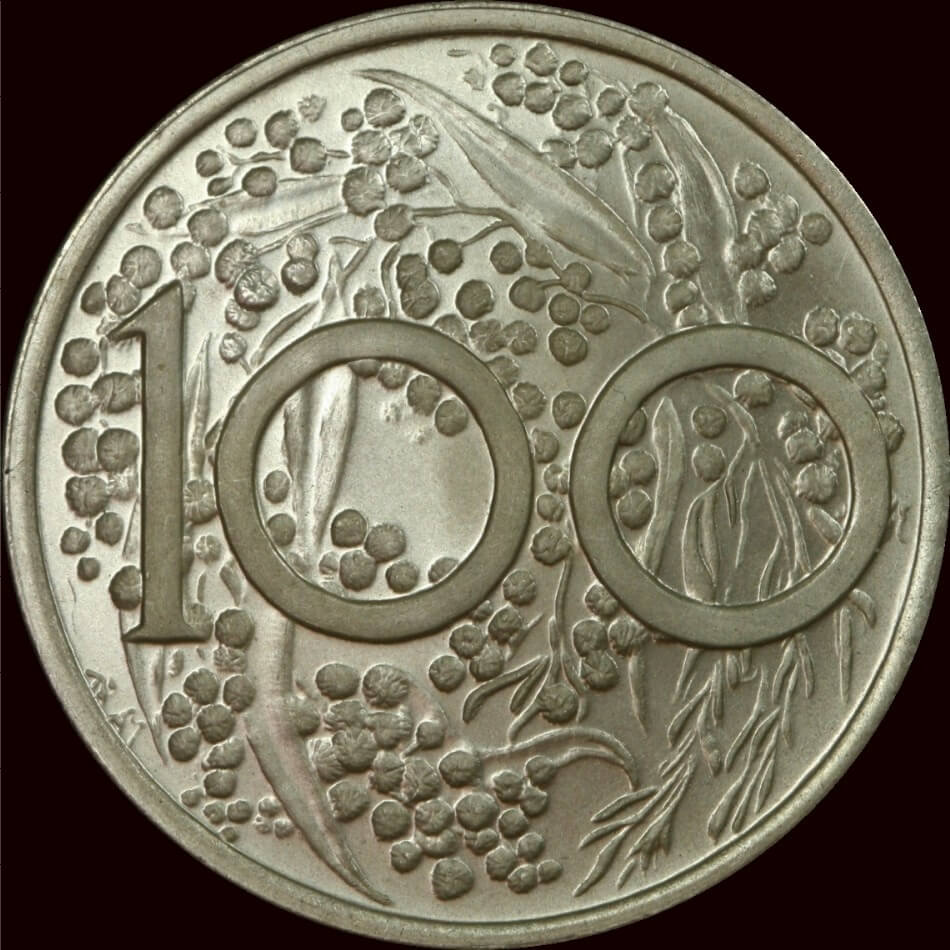Andor Meszaros - the 1967 Goose Dollar and the 2009 Silver Proof Coins

The introduction of decimal currency came at a time when untold thousands of Australians were searching their change for rare pennies and when the subject of our national coinage had a much higher profile in daily conversation than it does today. The release of a silver proof five-coin set by the Perth Mint earlier this year, one featuring each of the reverse designs submitted by Andor Mészáros' to the Advisory Panel on Coin Design, has brought the origin of the designs for the 1967 into clearer perspective. Their reverses were produced using the artist’s original coin plasters, having been released to Perth Mint for this expressed purpose by the Mészáros family.

This quote, from the editor of the Australian Coin Review Magazine in October of 1964, gives us some insight into the importance that many collectors placed on the subject: “... to the numismatist, this matter is a fairly important one. For that matter, it is also important to the non-collector. After all, he has to live with these designs, presumably for twenty or thirty years, and he should have ample right to criticise those chosen designs.”
In the same editorial, John Dean goes on to state that the designer of the coins “would have achieved a miracle if he satisfied everyone!”
The process by which the reverse designs for Australia's first decimal coins were selected certainly wasn't carried out without due consultation – the Commonwealth Government established an Advisory Panel on Coin Design, which subsequently commissioned six prominent Australian artists to submit a series of designs for consideration.
Andor Mészáros, A Trained Architect And Sculptor, One Of Australia’s Most Successful Medallion Designers
One of the six artists selected was Andor Mészáros, a trained architect and sculptor, and one of Australia’s most successful medallion designers. Although the designer finally selected by the Advisory Panel on Coin Design was Stuart Devlin, it seems that Mészáros' designs resonated with at least a modest range of numismatists at the time they were being considered – his proposed reverse design for the new Australian 20¢ coin was used as the basis of a reverse design submitted to a competition announced by the Australian Coin Review (ACR) Magazine in their December 1966 issue “for the best reverse design for a crown sized coin of Australia.”
Entries in this contest were received from locations as far away as the United States, the United Kingdom and New Zealand, and inspired spirited debate within the Australian numismatic community. Mészáros' winning reverse design was displayed to the general public on page 1 of the August 1967 edition of the ACR Magazine. It was essentially the same as the reverse design he conceived for the Australian 20¢ coin, however the denomination of “20” had been replaced by the word “AUSTRALIA” and the date (1967), in order to satisfy the competition's rules.

The editorial staff at the ACR magazine had stated that if the winning design was of a sufficient standard, it would be “struck as a souvenir in fine silver. These souvenirs [would] then be made available to coin collectors through the ACR and coin dealers throughout Australia.”
Issue 5 of Volume 4 of the ACR magazine, released in November 1967, confirmed that this commitment was to become a reality – 750 proof examples of the item were to be made available for sale at $13.50 each, in addition to 1,500 example with “the normal coin finish” at $10.00 apiece.
This Advertorial Did Not Mention That The Obverse Design For The Unofficial Crown
Interestingly, this advertorial did not mention that the obverse design for the unofficial crown was also a slight modification of another of Mészáros' submissions to the Advisory Panel on Coin Design – that of his submission for the reverse of the two cent piece. That design featured “fresh clusters of wattle, always a popular contender for Australia’s national floral emblem”, with the denomination expressed in numeric form in sans serif font in the centre.
The obverse design for the ACR's unofficial crown saw the number two removed from that submission, and replaced with the numerals “100” - a slightly petulant editorial in the other magazine competing for the Australian numismatic dollar at the time (the rather short-lived Australian Coin World) stated on page 81 of their January 1968 issue that the reverse design “features the figures 100 with no explanation as to what this signifies and the larger 1 and the background dots make the figure appear to read 1.00”.
.jpg)
Despite This Criticism, The ACR's Unofficial Crown Struck A Chord With Collectors
Despite this thinly veiled criticism, the ACR's unofficial crown struck a chord with collectors the world over straight away – the proof version was announced to have sold out completely in the February 1968 issue of the ACR magazine. Curiously, these coins continued to be advertised for some months afterwards.
The release of a silver proof five-coin set by the Perth Mint earlier this year, one featuring each of the reverse designs submitted by Mészáros' to the Advisory Panel on Coin Design, has brought the origin of the designs for the 1967 into clearer perspective. Their reverses were produced using the artist’s original coin plasters, having been released to Perth Mint for this expressed purpose by the Mészáros family.
During a speech to the Numismatic Association of Victoria regarding the reverse designs selected for Australia's decimal coins, Stuart Devlin stated that although “Australia has some very remarkable flowers when you have them in plaster, you find you can't use colour and the flowers tend to look not that much different from flowers of other countries. They [do] not look sufficiently Australian.”
Now that Mészáros's submissions are being made widely available for the collecting public to view and form an opinion on, it will be interesting to hear from collectors whether Devlin's comments hold up to the test of time, or whether current thought is that Mészáros' wattle and waratah could have been featured on our national coinage just as confidently as Devlin's echidna and frilled-neck lizard.